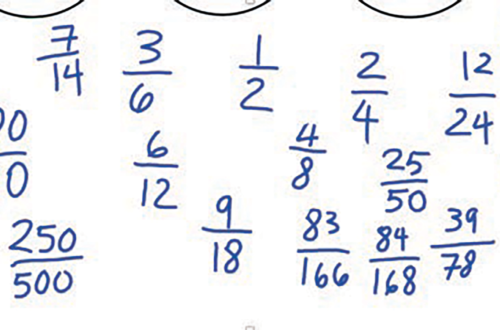Journal of the Mathematics Council of the Alberta Teachers’ Association
Volume 54 Issue 1, June 2017
I was reminded recently as I prepared for one of my undergraduate math courses about the beauty and exquisiteness in mathematics. The early cultures astounded us with their measurements, designs and depth of inquiry into mathematics. The golden ratio, found in nature, biology and even our bodies as well as embodied in art, music and architecture is absolutely stunning. We see beautiful geometric designs, tessellations, fractals and 3-D images that illustrate this mathematical beauty. Snowflakes, crystals of salt forming perfect cubes, tiling and Fermat equation generated surfaces dazzle us with this beauty. We see eloquent mathematical proofs and detailed solutions to problems. The beauty of logic, motion and statistics challenge us daily. To allow students to envision some of these aspects of math is wonderful. How can we teachers present some of these aspects to students throughout the curriculum? Can we help them to see the beauty that mathematics can create and that mathematics is?
A review by the Economist ( 1999) about Keith Devlin’s book The Language of Mathematics: Making the Invisible Visible ( 1998), states: “Devlin succeeds both in giving us a glimpse of the internal beauty of (mathematics) and in demonstrating its usefulness in the external world.” Devlin has expanded on a definition of math that one must truly stop and consider: mathematics is the identification and study of patterns (originally from W H Freeman’s Scientific American series Mathematics: The Science of Patterns). When we consider the strands of mathematics, and especially the strands we currently focus on in today’s curriculum, we can see that patterns exist in all of them. In fact, patterns are prevalent in all of them. The beauty of these patterns is something I truly hope all students, and people in general, can experience throughout their lives.
In this journal you can explore articles on group problem solving, university acceptance of high school mathematics and creativity. Ideas for lessons to use right away are provided in the Teaching Ideas section. Also included in this section is an article written by the Alberta Regional Professional Development Consortia (ARPDC) through the Elementary Mathematics Professional Leaming (EMPL) initiative which discusses the equal sign. (There are a tremendous amount of resources to explore and use for all math levels at http://learning.arpdc.ab.ca. Click on the ARPDC Learning Portal and then click Elementary Mathematics Professional Learning Resources link.) Make sure to check out the Math Competitions section in this journal as well with great questions and solutions provided. As always, we’ve included conversation starters, problem-solving moments, a book review and some website highlights. We hope to create thought and discussion on mathematics for you personally as well as for your mathematics setting.
As an ending note, a recently released report entitled Mathematics Review: Report to Premier and Minister (December 2016) was compiled by the Mathematics Curriculum Review Working Group with various panels of educators’ input. “The scope of the committee’s work was to provide insight into the transition from K-12 mathematics to post-secondary mathematics courses from their perspective” (p 4). This report is well worth the time to read to get a truly current perspective on mathematics education. The link is https://education.alberta.ca/media/3402136/final_mathematics-curriculum-review_05dec16pdf.pdf.
Thank you for your continued thought, effort and dedication to providing excellent math learning opportunities for students. You provide their beginning glimpses and experiences in mathematics and take students through to their secondary development of mathematics principles and thought. You have a valuable role to play!
Lorelei Boschman
Economist. 1999. Review of The Language of Mathematics: Making the Invisible Visible. by Keith Devlin. www.economist.com/node/325505 (accessed May 5, 2017).
1 to 2
3 to 3
Lorelei Boschman
4 to 6
History of Mathematics and the Forgotten Century
Glen Van Brummelen
7 to 7
Math PAT Changes Are Regressive and Counterproductive
Jonathan Teghtmeyer
8 to 8
Peter Liljedahl
9 to 10
NRICH Mathematics
11 to 15
What Problem Are They Posing? Viewing Group Problem Solving Through an Enactivist Lens
Nat Banting
16 to 19
University Acceptance of High School Mathematics in Alberta
Richelle Marynowski and Landry Forand
20 to 27
Creativity in Mathematics Classroom Settings: Recognizing the Collective Level
Ayman Aljarrah
28 to 29
When Is the World Going to Be Full?
David Martin
30 to 33
Trigonometry Workshop for High School
Rosalind Carson
34 to 38
Sarah Quebec Fuentes
39 to 43
Understanding the Equal Sign Matters at Every Grade
Geri Lorway
44 to 80
Alberta Mathematics Competitions 2015/16
81 to 82
Richard Hoshino
83 to 83
Lorelei Boschman
84 to 85



